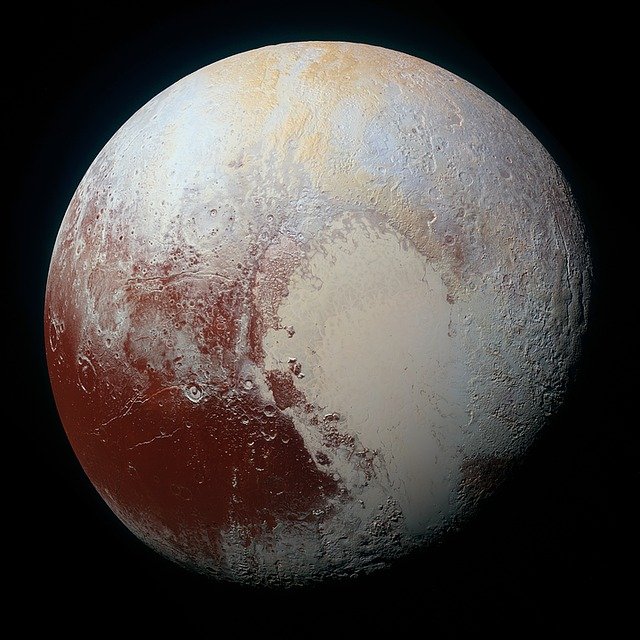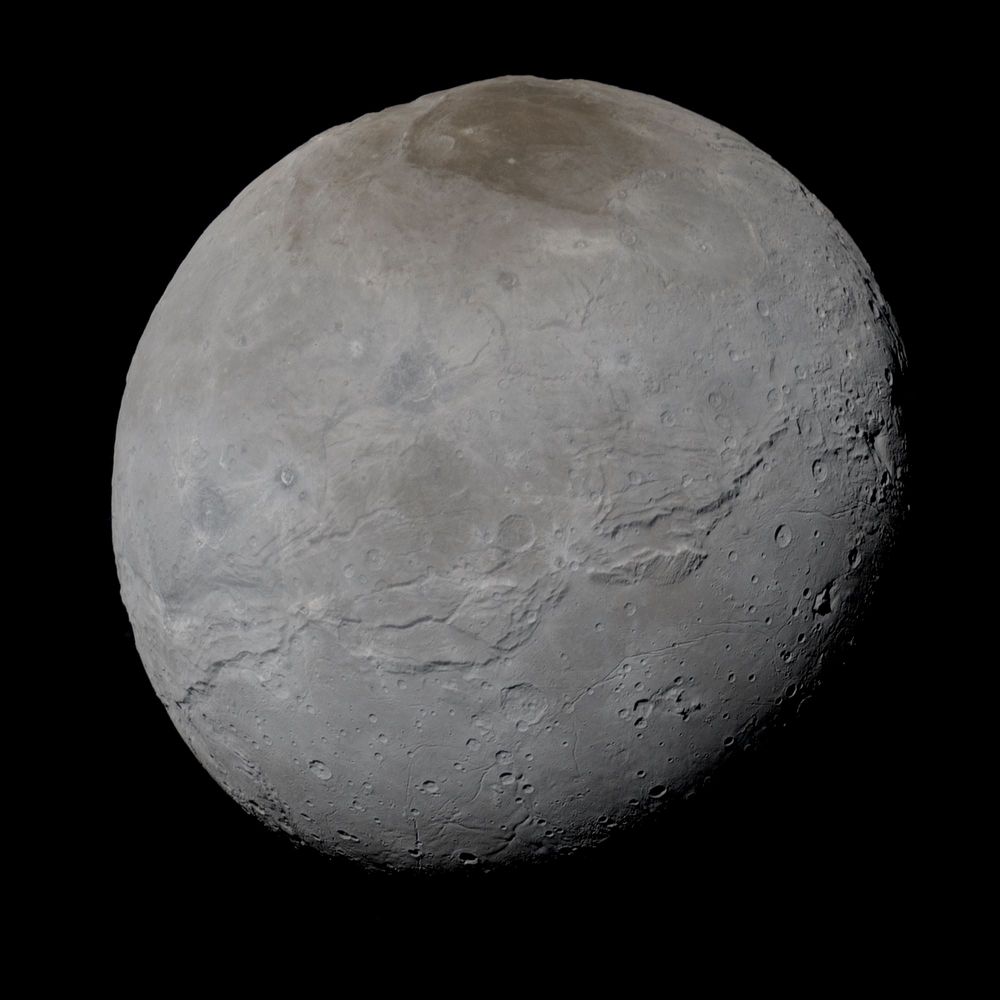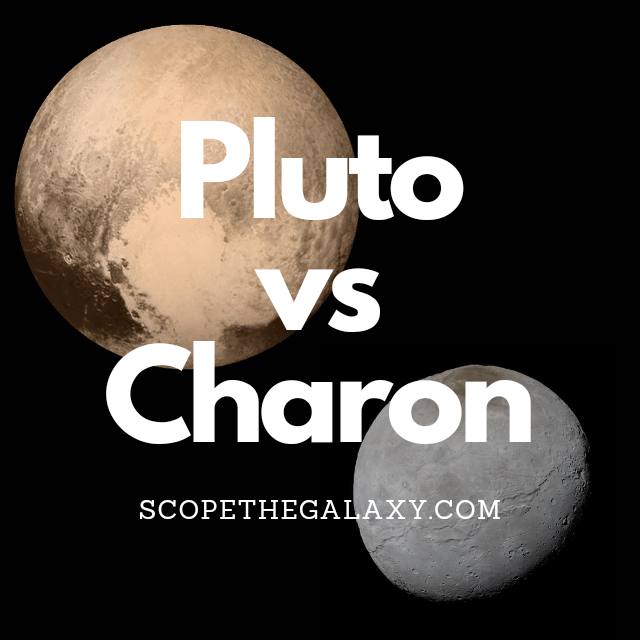*This post may contain affiliate links. This means we may make a commission if you purchase an item using one of our links*
The main differences between Pluto and Charon is that Pluto is a dwarf planet with 5 moons orbiting it and itself orbiting the Sun whilst Charon is Pluto’s largest moon and orbits the dwarf planet. Pluto is also bigger with a diameter of 2,370km whilst Charon is smaller with a diameter of 1,212km.
There are a few other differences between the two so, continue reading for a thorough look at each entity below, along with their similarities and differences.
What Is The Planet Pluto?
Table of Contents

In the past Pluto was the 9th farthest official planet in our solar system however, in 2006 after many debates between astronomers, the International Astronomical Union officially downgraded it to a dwarf planet.
The reason for this downgrade at the time was primarily down to Pluto simply being very small when compared to every other planet and even the moons orbiting these planets. Pluto’s dwarf status is debated still to this day but, for now it still remains under this dwarf bracket for a planet
Its diameter for example is only 2,370km, which is a third of Earth’s Moon. With that being said, despite the significant size discrepancy Pluto shows, it still does have more moon like objects orbiting it than Earth and I’m not saying just one more.
In total this terrestrial dwarf planet has 5.
Pluto’s atmosphere consists mostly of molecular nitrogen whilst molecules of methane and carbon monoxide have been observed also. As for its surface, it consist mostly of frozen nitrogen, methane, and carbon monoxide ices.
One of Pluto’s most unique characteristic is that Charon (its largest moon) is tidally locked to it and vice versa, which means that the two essentially orbit each other.
In essence only one side of Charon and one side of Pluto surface will face each other at any given time.
Pluto’s temperature is between -222 to -232 degrees Celsius based on how close it gets to the Sun when orbiting it, whilst its core temperature isn’t anything too special sitting around 500 – 1,000 degrees Celsius.
The main reason it’s as cold as it is and has a relatively cold core in comparison to the other planets would be, which is mostly down to its size. A larger size would mean more mass could be compressed at the center which would produce more heat at the core.
Pluto’s orbit is also different from the other main plants in our solar system, following an elliptical orbital path as opposed to the circular path the others take. As a result of its distance from the Sun, Pluto will complete each one of these elliptical cycles around once every 247.78 years.
Even its rotational cycle is very slow, where one cycle is completed in 157 hours. Another interesting fact is the Pluto’s axial tilt is almost on its side at 57 degrees, similar to Uranus.
What Is The Moon Charon?

Charon is the largest of Pluto’s moons, first discovered on 22nd June 1978. The surface of this icy world is frozen with nitrogen and methane ice; it may also hold some water ice. While Pluto possesses a reddish hue, Charon is closer to a neutral shade of grey; this suggests the two bodies have different compositions.
Scientists named this moon after the mythical ferryman, Charon, who once carried souls across the Acheron river. This river is one of five legendary rivers that could lie beneath the surface of Pluto.
The formation of Charon remains something of a mystery to scientists. However, this moon may have formed around 4.5 billion years ago when an object traveling at immense speed collided with Pluto. Its average distance from the Sun is approximately 3.6 billion km.
Charon is almost half the size of its planet at 1,212km, where scientists refer to these two bodies as a “double dwarf planet system,” and the chilly temperatures vary from minus 23 to minus 258 degrees Celsius.
Charon takes 153 hours to orbit its planet at an average distance of 19,640km, and it is tidally locked, meaning the same side of the moon always faces Pluto. Pluto also experiences a tidal lock to Charon, so the same two sides always face one another.
Among the fascinating features of this ice moon are the ice volcanoes that could exist on the surface. Observations from the Gemini observatory suggest that Charon could have a form of cryovolcanism known as ice-particle geysers.
The frigid world also has a canyon between seven and nine kilometers deep. (To put that into perspective, Mount Everest has a height of 8.8km).
Similarities Between Pluto And Charon
Charon and Pluto do have a few similar features, which would include the below:
- Both have a hotter central core.
- Both orbit their respective entity in an elliptical pattern.
- Both are terrestrial based entities.
- Both have an atmosphere and a rocky surface.
- Both are spherical in shape.
- Both are tidally locked to each other.
- Both have no rings surrounding them.
- They both complete an orbit around the Sun in 247.78 years.
Differences Between Pluto And Charon
In regards to the differences between the two, they include the following:
- Charon is smaller with a diameter 1,212km compared to Pluto’s 2,370km.
- Pluto has 5 moons whilst Charon has 0.
- Pluto is a dwarf planet whilst Charon is a natural satellite.
- Pluto orbits the Sun whilst Charon orbits Pluto and the Sun.
- A day on Pluto takes 157 hours whilst a day on Charon is 153 hours.
- Pluto has an axial tilt of 57 degrees whilst Charon’s axial tilt is straighter in comparison.
- Charon’s average temperature is -23 to -253 degrees whilst Pluto’s average ranges between -222 and -232 degrees Celsius.
- Charon’s atmosphere is near enough non-existent whilst Pluto’s atmosphere is composed of 90% nitrogen and 10% methane, carbon monoxide among other complex molecules.
- Charon’s gravity is 0.288 m/s² compared to Pluto’s that is 0.62 m/s².
- Pluto’s mass is 1.309 x 10^22 kg whilst Charon’s mass is 1.58×10^21 kg.
Summary
Pluto and Charon have a lot in common as they are both located in the same region, are tidally locked to each other and also elliptically orbit their respective entities.
There are also obvious differences that completely separate the two too such as their size, mass, their axial tilt, composition of their atmosphere and their overall status where one is a dwarf planet and the other a natural satellite.


If the two are tidally locked, then Pluto is a satellite of Charon as much as Charon is a satellite of Pluto because they orbit each other. In the case of Earth and the moon, only the moon is tidally locked.